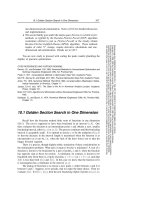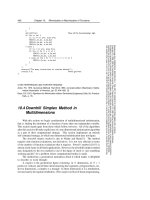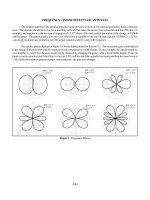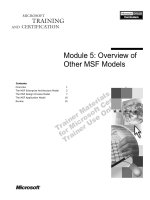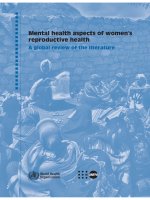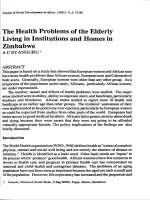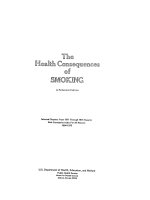Tài liệu Respiratory health effects of indoor air pollution docx
Bạn đang xem bản rút gọn của tài liệu. Xem và tải ngay bản đầy đủ của tài liệu tại đây (311.35 KB, 8 trang )
THE YEAR OF THE LUNG
Series editor : John F. Murray
INT J TUBERC LUNG DIS 14(9):1079–1086
© 2010 The Union
REVIEW ARTICLE
2010
Respiratory health effects of indoor air pollution
R. Perez-Padilla,* A. Schilmann,
†
H. Riojas-Rodriguez
†
*
Instituto Nacional de Enfermedades Respiratorias, Mexico City,
†
Instituto Nacional de Salud Pública,
Cuernavaca, Morelos, Mexico
Everyone has heard, and t-shirts can be bought emblazoned with, the popu-
lar saying ‘Home is where the heart is’. Lungs, too, it turns out. Hearts and
homes convey images of peace and security, protection and shelter. Lungs
and homes, as we learn from this month’s 2010: Year of the Lung feature
article, have a different association. Homes of poor people are where lungs
are likely to be injured from exposure to exceedingly high concentrations of
toxins in smoke from biomass fuels and coal used in cooking and heating.
Indoor air pollution, we are told, ‘accounts for a substantial proportion of
the global burden of disease in developing countries’. And that’s not all: ac-
cording to Doctors Perez-Padilla, Schilmann and Riojas-Rodriguez it is going
to get worse before it gets better. Clean fuels are expensive. Ef cient stoves
can alleviate some of the emissions, but both cultural and behavioral barriers
stand in the way of widespread acceptance. Much more needs to be done.
J F. M, Series Editor
e-mail:
Domestic pollution is relevant to health because people
spend most of their time indoors. One half of the world’s
population is exposed to high concentrations of solid
fuel smoke (biomass and coal) that are produced by in-
ef cient open res, mainly in the rural areas of develop-
ing countries. Concentrations of particulate matter in
kitchens increase to the range of milligrams per cubic
meter during cooking. Solid fuel smoke possesses the
majority of the toxins found in tobacco smoke and has
also been associated with a variety of diseases, such as
chronic obstructive pulmonary disease in women, acute
respiratory infection in children and lung cancer in
women (if exposed to coal smoke). Other tobacco
smoke-associated diseases, such as tuberculosis, asthma,
respiratory tract cancer and interstitial lung diseases,
may also be associated with solid fuel smoke inhalation,
but evidence is limited. As the desirable change to clean
fuels is unlikely, efforts have been made to use ef cient,
vented wood or coal stoves, with varied success due to
inconsistent acceptance by the community.
KEY WORDS: biomass smoke; coal smoke; indoor pol-
lution; COPD; acute respiratory infection
Previous articles in this series, Int J Tuberc Lung Dis 2010 Editorials:
Murray J F. 2010: The Year of the Lung. 14(1): 1–4; Castro K G, Bell
B P, Schuchat A. Preventing complications from 2009 infl uenza A
(H1N1) in persons with underlying lung diseases: a formidable
challenge for 2010 Year of the Lung. 14(2): 127–129; Barker K. Ca-
nadian First Nations experience with H1N1: new lessons or peren-
nial issues? 14(2): 130; Annesi-Maesano I. Why hasn’t human ge-
netics told us more about asthma? 14(5): 521–523; Billo N E. Good
news: asthma medicines for all. 14(5): 524; Goodman P C. Com-
puted tomography scanning for lung cancer screening: an update.
14(7): 789–791; Price K A, Jett J R. Advances in treatment for non-
small cell lung cancer. 14(7): 792–794; Kumaresan J, Enarson D A.
Inequities in lung health: challenges and solutions. 14(8): 931–
934. Unresolved issues: Lalloo, U G. Drug-resistant tuberculosis:
reality and potential threat. 2010; 14(3): 255–258. Review articles:
Murray J F. The structure and function of the lung. 14(4): 391–396;
Daley C L, Griffi th D E. Pulmonary non-tuberculous mycobacterial
infections. 14(6): 665–671.
Correspondence to: Rogelio Perez-Padilla, Instituto Nacional de Enfermedades Respiratorias, Calzada de Tlalpan 4502,
Col. Sección XIV, Deleg. Tlalpan, 14080 México DF, México. Tel: (+52) 55 5487 1773. e-mail:
SUMMARY
BREATHING OF POLLUTED AIR is as old as man-
kind, particularly since the domestication of re. Evi-
dence of re accompanied hominid remains from
500 000 years ago in China,
1
and offered people then
a survival advantage through cooking foods, heating,
and keeping bugs and beasts at a distance. When peo-
ple built shelters for dwellings, they also brought pol-
lutants into the indoor living space.
2
Today, burning biomass—principally wood, crop
residues, and dung—remains an important source of
exposure to a variety of toxins, mainly in the rural
areas of developing countries. Humans have cooked
in a similar manner for thousands of years. Fuels that
1080 The International Journal of Tuberculosis and Lung Disease
are found at the top of the energy ladder, which are
cleaner but also more expensive, have a much more
recent history.
The exploitation of fossil fuels that are integral to
modern living has been part of the rapid technologi-
cal, social, and cultural changes of the past 250 years.
Although such changes have brought about undeni-
able bene ts, they have also contributed to the pollu-
tion of local and regional environments due to the re-
lease of a great number of chemicals.
3
People living in
industrialized countries have other exposures due to
more energy-ef cient houses built from a variety of new
building materials, plus chemicals and pets, in addition
to a more sedentary lifestyle spent mainly indoors.
Total human exposure to air pollutants is deter-
mined by the concentrations found outdoors and in-
doors in the different microenvironments and the time
spent in each of these environments, commonly called
the time-activity pattern. People spend more than one
half of their time indoors, with variations attribut-
able to age, gender, and place. The National Human
Activity Pattern Survey (NHAPS) showed that people
in the United States and Canada spent an average of
87% of their time in enclosed buildings, and about
6% of their time in enclosed vehicles.
4
The average
proportion of time spent indoors in rural areas of de-
veloping countries is, for women, 70% in Kenya and
75% in Mexico.
5,6
Although the fraction of time spent
indoors is less in rural than in urban areas, individual
exposures are often huge due to high concentrations
of pollutants in indoor air. Therefore, indoor exposure,
including that in occupational settings, dominates
total exposure for many pollutants.
Indoor sources of air pollution can be categorized
by type of source and by pollutant group, as shown
in Table 1, which also depicts the main health effects
Table 1 Sources and characteristics of varied indoor air pollutants and associated health effects
7
Pollutant* Sources and characteristics Associated health effects
Environmental
tobacco
smoke (ETS)
8
A complex mixture of >4000 identifi ed
chemicals found in both vapor and particle
phases. Many of these chemicals are known
toxic or carcinogenic agents.
Non-smoker exposure to ETS-related toxic and
carcinogenic substances will occur in indoor
spaces where there is smoking.
Secondhand smoke causes disease and even premature death in
children and in adults who do not smoke.
Children: sudden infant death syndrome (SIDS), acute respiratory
infections (including bronchitis, bronchiolitis and pneumonia),
tuberculosis, and more severe asthma, varied respiratory
symptoms, delayed lung growth. Strong evidence of increased
middle ear effusion, reduced lung function, and reduced lung
growth.
Adults: lung cancer in spouses of smokers, impaired breathing,
aggravation of existing respiratory and cardiovascular disease,
lowered defenses against infections, exacerbation of allergic
responses.
Biological
pollutants
Dust mites, molds, fungus, bacteria, products
from men and pets, pests (cockroaches,
mice, rats) enhanced by damp indoors. Also
microbial products such as endotoxins,
microbial fragments, peptidoglycans and
varied allergens.
Major concern is allergic reactions, which range from rhinitis or
conjunctivitis to severe asthma. Indoor allergens are important
causes and triggers of asthma: dust mite, cats, cockroaches,
dogs, and indoor molds and fungus.
Also possible infections, hypersensitivity pneumonitis, and toxic
reactions.
Volatile organic
compounds
(VOCs)
VOCs (toxic gases or vapors emitted at room
temperature from certain solids or liquids)
include formaldehyde, benzene, and
perchloroethylene, among many others. The
semi-VOCs category includes compounds
such as phthalates.
Sources include thousands of common products
that are used daily, personal care products,
household products such as fi nishes, rug and
oven cleaners, paints and lacquers (and their
thinners), paint strippers, pesticides, dry-
cleaning fl uids, building materials, and home
furnishings.
Adverse effects are varied, including eye and upper and lower
respiratory irritation. Formaldehyde has been classifi ed as a
probable human carcinogen by the Environmental Protection
Agency (EPA), but can cause rhinitis, nasal congestion, rash,
pruritus, headache, nausea, vomiting, dyspnea, and epistaxis.
Symptoms after exposure to pesticides may include headache,
dizziness, muscular weakness, and nausea. In addition, some
active ingredients and inert components of pesticides are
considered possible human carcinogens.
Radon A naturally occurring underground radioactive
gas resulting from the decay of radium, itself
a decay product of uranium.
Decay products, either free or attached to
airborne particles, are inhaled.
Known human carcinogen. Radon is the estimated second leading
cause of lung cancer, following smoking.
While the risk to underground miners has long been known, the
potential danger of residential radon pollution has been widely
recognized only since the late 1970s, with the documentation
of high indoor levels.
Asbestos Asbestos may be found predominantly in
insulation for heating systems, and mixed
with cement, it is used in many countries for
roofs and water deposits. When asbestos-
containing material is damaged fi bers may be
dispersed into the air.
Known human carcinogen: lung cancer or mesothelioma, with
synergic effects with tobacco smoking by approximately fi ve-
fold. Asbestosis requires important exposures that are more
common in occupational settings.
*
Combustion products are described in Table 2, which describes common pollutants in industrialized and developing countries except by occupational sources.
Other possible toxins are lead from painted surfaces and free radicals.
Indoor pollution and lung diseases 1081
associated with these pollutants.
2
Sources of pollution
may result from combustion processes for cooking
and heating; from human activities, such as smoking,
presence of biological agents, and use of chemical
substances; and from emissions of construction ma-
terials and furniture.
7
Indoor concentrations of pol-
lutants depend on the quantity of emissions, the vol-
ume of the polluted space, and the rate of exchange
between indoor and outdoor air. The principal indoor
pollutants vary in rural and urban areas, and in de-
veloping and industrialized countries, but they are a
source of disease everywhere. Industrialized countries
employ several times more energy per person than
developing countries, but because cleaner fuels are
utilized, there is actually less exposure to pollutants
than in developing countries.
This review will not deal with occupational expo-
sure or environmental tobacco smoke;
8
it will center
on the health effects of exposure to solid fuel smoke,
mainly in developing countries. Recent reviews have
dealt with domestic indoor pollution as a health prob-
lem in industrialized countries.
9,10
INDOOR AIR POLLUTION IN
DEVELOPING COUNTRIES
Household use of solid fuels is the most widespread
source of indoor air pollution worldwide; solid fuels
are extensively used for cooking and home heating
in developing countries, especially in rural areas.
11–13
About 3 billion people in the world use solid fuels:
2.4 billion use biomass (wood, charcoal, animal
dung, crop wastes), and the remainder utilize coal
for the majority of their household energy needs.
14
The percentage of people using solid fuels varies
widely among countries and regions, ranging from
respectively 77%, 74%, and 74% in sub-Saharan
Africa, South-East Asia, and the Western Paci c Re-
gion, to 36% in the Eastern Mediterranean Region,
and 16% in Latin America and the Caribbean and in
Central and Eastern Europe. In the majority of in-
dustrialized countries, solid fuel use falls below the
<5% mark.
15
The world map of solid fuel use can be super-
imposed nearly perfectly on that of socio-economic
development. Moreover, use of solid fuels is invari-
ably associated with poverty in countries, in commu-
nities within a country, and in households within a
community. Health studies on indoor air pollution
should always take into account socio-economic fac-
tors, which are powerful determinants of both dis-
ease and solid fuel use, and are dif cult to control for
in studies of solid fuel combustion products (Figure).
For example, a study in Ghana concluded that pov-
erty, lack of education, and a lack of awareness were
the major factors affecting choice of cooking fuel,
place of cooking, and level of respiratory health.
16
In developing countries, especially in rural areas,
these fuels are often burned inef ciently in open res,
with high emission factors, leading to extremely high
levels of indoor and local air pollution, many times
higher than the limits speci ed by international stan-
dards of ambient air quality. Although open res have
energy ef ciencies of only 5‒10%, users perceive ad-
ditional bene ts, including space heating, protection
from insects, and the exibility of using a wide vari-
ety of fuels in different seasons.
17
Levels of indoor particulate matter, which are
commonly measured in milligrams per cubic meter,
reach transient peaks of as high as 20‒80 mg/m
3
when res are started or stirred; these peaks form
up to half of total exposure in women, as they are
required to stay close to the re while cooking. Par-
ticulate matter (PM) in biomass smoke has signi -
cant amounts of respirable size particles (mean aero-
dynamic diameter <10 μm, PM
10
) and of particles
<2.5 μm (PM
2.5
), which are able to penetrate deeply
into the lung. The concentration of particulate matter
has been employed as an indicator of exposure to
varying pollutants from biomass and other solid fuel
indoor pollution. Other typical pollutants include
carbon monoxide and a variety of toxins, carcino-
gens, and polycyclic aromatic hydrocarbons, which
closely follow tobacco smoke toxins, except for
nicotine.
11,18
In view of the high concentrations of the many
hazardous substances in smoke, exposure to indoor
air pollution is particularly important for homemak-
ers and young children, and accounts for a substan-
tial proportion of the global burden of disease in de-
veloping countries.
3,14
The use of biomass stoves is also a source of in-
door pollution in industrialized countries, but stoves
are usually vented and more ef cient, producing con-
centrations of pollutants that are only a fraction of
those typically found in developing countries. They
are nevertheless above standard limits, have a nega-
tive impact on health and contribute signi cantly to
outdoor pollution. Signi cant exposure to biomass
smoke can also result from forest res.
Figure Interactions between poverty, exposure to solid fuel
smoke and ill health. One of the mechanisms linking poverty to
disease is through the domestic inhalation of solid fuel smoke.
1082 The International Journal of Tuberculosis and Lung Disease
HEALTH EFFECTS OF SOLID FUEL SMOKE
INDOOR POLLUTION
The adverse effects on respiratory health of products
of incomplete solid-fuel combustion are summarized
in Table 2, which also includes some of the known or
proposed mechanisms of damage. Exposure to solid
fuel smoke can be lifelong, beginning before birth
and early infancy, and continuing during adulthood,
especially in women, who are traditionally charged
with the task of cooking. Exposure is longer in cold
communities that require re-related heating, and may
adversely impact lung growth and development, both
directly and through an increase in lung infections.
Indoor air pollution from indoor burning of solid
fuels has been associated with an increased risk of
several diseases and health conditions (Table 3). In
general, studies are scarce, and show varied health
outcomes. Moreover, they commonly lack a quantita-
tive exposure assessment, and rely instead on qualita-
tive or semiquantitative indicators, such as the use
of open re indoors. The majority of relevant associ-
ated diseases
19
are acute respiratory infections and
chronic bronchitis in childhood and chronic obstruc-
tive pulmonary disease (COPD) in women in develop-
ing countries. The amount of time that children and/
or women spend in proximity to res is the crucial
determinant of the health impact of indoor air pollu-
tion.
20
For other health outcomes, the adverse effects
of exposure to solid fuel smoke from coal or biomass
Table 2 Health-damaging pollutants as products of incomplete combustion of solid fuels
11,12,21
Smoke phases Characteristics Mechanism and associated health effects
Particulate Variety of particulates, different size and composition
Respirable size, mean aerodynamic diameter <10 μm (PM
10
)
Fine particles <2.5 μm (PM
2.5
) can be deposited in the lower
respiratory tract
Organic and inorganic (metals, for example) pollutants can
be carried by particulate matter
In some cases, carcinogenic pollutants are attached to the
particle, for example, higher molecular weight (5-ring and
more) polycyclic aromatic hydrocarbons (PAHs) such as
benzo(a)pyrene
Cause irritation and oxidative stress (additive to other
compounds) producing lung and airway infl ammation,
hyperresponsiveness, and in long-term exposures
airway remodeling and emphysema
Reduced mucociliary clearance and macrophage
response
Carcinogenic
Gaseous Carbon monoxide (CO) Binds to hemoglobin interfering with transport
of oxygen
Headache, nausea, dizziness
Low birth weight, increase in perinatal deaths.
Feto-toxicant, has been associated with poor
fetal growth
Nitrogen oxides (NO
x
) Irritant, affecting the mucosa of eyes, nose, throat,
and respiratory tract
Increased bronchial reactivity, longer-term exposure
increases susceptibility to infections
Sulfur dioxide (SO
2
), mainly from coal Irritant, affecting the mucosa of eyes, nose, throat,
and respiratory tract
Increased bronchial reactivity, bronchoconstriction
Hundreds of different hydrocarbons
Aldehydes and ketones
Lower molecular weight (2–4 ring) PAHs
Some of these are classifi ed as carcinogenic: 1,3 butadiene;
benzene; styrene, and formaldehyde
Adverse effects are varied, including eye and upper
and lower respiratory irritation, systemic effects
Carcinogenic
Others possible are arsenic and fl uorine from coal combustion.
Table 3 Respiratory diseases associated with solid fuel use
Health outcome
Meta-analysis
RR (95%CI)
19
*
Strong evidence
†
Acute lower respiratory infection (ALRI)
in children <5 years of age in
developing countries
2.3 (1.9–2.7)
1.78 (1.45–2.18)
23
Chronic obstructive pulmonary disease
(COPD) in women >30 years of age,
mainly homemakers residing in rural
areas of developing countries
3.2 (2.3–4.8)
2.14 (1.78–2.58)
18
Lung cancer (coal smoke exposure) in
women >30 years of age 1.9 (1.1–3.5)
Moderate evidence
‡
COPD in men >30 years of age 1.8 (1.0–3.2)
Lung cancer (coal-smoke exposure) in
men >30 years of age 1.5 (1.0–2.5)
Lung cancer (biomass smoke exposure)
in women >30 years of age 1.5 (1.0–2.1)
Asthma in children aged 5–14 years 1.6 (1.0–2.5)
Asthma, >15 years of age 1.2 (1.0–1.5)
Tuberculosis, >15 years of age 1.5 (1.0–2.4)
Insuffi cient evidence
§
Upper airway cancer
Low birth weight and perinatal
mortality
Cardiovascular diseases
*
Meta-analysis results from reference 19, unless otherwise stated.
†
Strong evidence: Some 15–20 observational studies for each condition, from
developing countries. Evidence is consistent (signifi cantly elevated risk in most,
although not in all, studies); the effects are sizable, plausible, and supported
by evidence from outdoor air pollution and smoking.
19
‡
Small number of studies, not all consistent (especially for asthma, which
may refl ect variations in defi nitions and condition by age), but supported by
studies of outdoor air pollution, smoking, and laboratory animals.
19
§
Insuffi cient for quantifi cation based on available evidence.
19
RR = relative risk; CI = confi dence interval.
Indoor pollution and lung diseases 1083
is expected, as from exposure to tobacco smoke, but
information is lacking or scarce about other conse-
quences such as low birth weight and adverse peri-
natal outcomes (stillbirth).
21
Biomass smoke in Gua-
temalan women has been shown to increase diastolic
blood pressure.
22
Respiratory infections
Smoke inhalation alters several mechanisms of lung
defense, including the ef cacy of both the mucociliary
escalator and the macrophage function.
11
Exposure
to biomass smoke has been clearly associated with an
increase in the severity of respiratory infections in chil-
dren,
23
a notorious cause of disease and death in de-
veloping countries. Furthermore, the risk of pneumo-
nia in young children is increased by exposure to
solid fuels by a factor of 1.8.
Several studies also found an increased risk of tu-
berculosis in those exposed to biomass stoves, al-
though such studies are scarce and the results mixed.
24
Biomass smoke exposure is likely only one of the im-
portant mechanisms by which poverty increases the
incidence of respiratory infections and tuberculosis
(Figure, Table 3).
Chronic bronchitis and chronic obstructive
lung disease
Women who cook with solid fuels have increased
respiratory symptoms, including chronic cough and
phlegm, a decrease in lung function,
25
and an in-
creased incidence of COPD,
26,27
which resembles cig-
arette smoking-related COPD both clinically and in
its prognosis.
28,29
However, tobacco smoking tends
to give rise to COPD with more emphysema and gob-
let cell hyperplasia, whereas domestic exposure to
wood smoke tends to produce COPD with more small
airway brosis and anthracosis, and hyperplasia of the
pulmonary artery intimal.
30
The typical patient with
biomass-smoke-associated COPD is an elderly woman
born in a rural area with lifelong exposure to wood
smoke, who has mild to moderate air ow obstruc-
tion and normal or nearly normal pulmonary transfer
factor of carbon monoxide (TL
CO
) and whose chest
X-ray shows mainly bronchial wall thickening. Hy-
poxemia can be important, especially in communities
at moderate or high altitude, or in elderly or obese
women. Treatment should be as for COPD in smok-
ers, insisting on the reduction of exposure.
Other respiratory diseases
Tobacco smoking has been strongly associated with
several respiratory diseases, and a similar association
with biomass smoke has been studied, with limited
success. Approximately 10‒15% of lung cancers oc-
cur in subjects who have never smoked.
31
Coal-smoke
exposure is now considered by the International
Agency for Research on Cancer (IARC) as a carcino-
gen (Group 1) in never smokers, whereas exposure
to biomass smoke is considered in Group 2 as proba-
bly a human carcinogen.
32
Although evidence is lim-
ited, biomass smoke has substantial concentrations
of known carcinogens, such as polycyclic aromatic
hydrocarbons, benzo[a]pyrene, formaldehyde, and
benzene, with mutagenic and genotoxic effects.
11,32
In a recent study, exposure to biomass smoke was as-
sociated with hypopharyngeal cancer.
33
Exposure to solid fuel smoke may act as an asthma
trigger, but in addition exposure to biomass smoke
has been associated with an increased prevalence of
asthma.
34,35
Tobacco smokers are more likely than
non-smokers to develop several interstitial lung dis-
eases, including idiopathic pulmonary brosis, Lang-
erhans cell histiocytosis, desquamative interstitial
pneumonia, and bronchiolitis-associated interstitial
lung disease. However, an association between solid
fuel smoke exposure and interstitial lung disease has
been evaluated in only a few studies,
12,36
which have
led to reports of reticulonodular opacities in the chest
roentgenogram in individuals exposed not only to
biomass smoke but often also to inorganic dusts.
36
BURDEN OF DISEASE
According to World Health Organization estimates,
worldwide exposure to solid fuel smoke produces
1.6 million deaths yearly, 693 000 due to COPD and
910 000 due to acute lower respiratory infections
(ALRI), as well as 38.5 million disability adjusted life
years (DALYs), most due to ALRI, being the eighth
overall cause of DALYs in the world and the eleventh
cause of death.
19
This is likely an underestimation, as
only diseases with a strong evidence base, i.e., COPD,
ALRI, and lung cancer from coal burning, are consid-
ered (Table 3).
INTERVENTIONS
The use of biomass fuels in developing countries is
likely to remain stable or even increase in the near fu-
ture, as few rural families can afford a fuel that is
higher on the energy ladder, such as lique ed petro-
leum gas or electricity, which are cleaner but more
expensive. Also, for cultural reasons, the combined
use of biomass with modern fuels is widespread, ac-
cording to a ‘multiple fuel model’ of development.
37
One approach to reduce the health burden related to
biomass fuel has been the provision of low-cost, im-
proved wood-burning stoves in rural areas of devel-
oping countries.
14
These relatively simple and cost-
ef cient technologies can double the energy ef ciency
of their ‘traditional’ counterparts and reduce indoor
pollution. Factors determining the success of these in-
terventions and long-term use in the community in-
volve complex interactions of technological, behav-
ioral, economic, and infrastructural factors. Empirical
research may provide technological interventions that
1084 The International Journal of Tuberculosis and Lung Disease
are robust with regard to cultural tradition and be-
havioral factors.
The Chinese National Improved Stoves Program
has reported the installation of more than 180 million
stoves in rural households since the early 1980s,
17,38
and a retrospective cohort study showed that the in-
cidence of both lung cancer and COPD has decreased
over time since stove improvement.
38
A program in
India (Improved Chulhas) was initiated in 1983, but
required adjustments and has been replaced by a new
program, the National Biomass Cookstove Initiative,
intended to provide cleaner, more ef cient biomass-
fueled stoves in rural communities.
17,39
Community intervention trials using ef cient wood
stoves are the best way to separate exposure to solid
fuel smoke from poverty when evaluating potential
health effects. Two recent examples of such trials are
the use of the Plancha stove in Guatemala
40
and the
Patsari stove in Mexico.
41
Compared with open res,
the Patsari stove has been shown, under actual eld
conditions, to cause average reductions of 70% in in-
door air pollution concentrations,
6
of 56% in house-
hold fuel consumption,
42
and of 74% in greenhouse
gas emissions.
43
Accordingly, use of an improved bio-
mass stove has reduced several adverse health mark-
ers, such as respiratory symptoms, sore eyes, and
headache among women in Mexico and Guatemala,
even after only a short follow-up time.
41,44
In Mexico,
a reduced decline in forced expiratory volume in one
second (FEV
1
) among Patsari stove users (31 ml)
compared with open re users (62 ml) was observed
over 1 year of follow-up, a difference similar to
what occurs after smoking cessation.
41
Other inter-
ventions have been proposed to reduce child expo-
sure to indoor air pollution, including stove mainte-
nance practices, increasing house ventilation while a
re is burning, reducing the time that children spend
close to burning res, and reducing the duration of
solid-fuel burning.
45,46
FUTURE DIRECTIONS
Indoor pollution will continue to be an essential eld
for health studies and interventions, because exposure
to varied indoor substances will likely increase in com-
ing years. Better studies dealing with genetic suscepti-
bility to indoor pollutants, their carcinogenic effect
and their impact on lung growth, lung development
and, later on, lung aging, are also required. To answer
several of these questions, longitudinal studies are re-
quired. A formal evaluation of improved stove pro-
grams from many viewpoints is also essential to im-
prove guidance for countries and communities as they
implement their own programs. Although local adap-
tation of programs will always be required, improved
biomass stoves will likely be more common, with bet-
ter community acceptance, reduced burden on forests,
and increased spare time for homemakers.
References
1 James S R. Hominid use of re in the lower and middle pleisto-
cene: a review of the evidence. Curr Anthropol 1989; 30: 1–26.
2 Spengler J D, Samet J M. A perspective on indoor and outdoor
air pollution. In: Samet J M, Spengler J D, eds. Indoor air pol-
lution: a health perspective. Baltimore, MD, USA: Johns Hop-
kins University Press, 1991: pp 1–29.
3 Wilkinson P, Smith K R, Joffe M, Haines A. A global perspec-
tive on energy: health effects and injustices. Lancet 2008; 371:
1145–1147.
4 Klepeis N E, Nelson W C, Ott W R, et al. The National Hu-
man Activity Pattern Survey (NHAPS): a resource for assessing
exposure to environmental pollutants. J Expo Anal Environ
Epidemiol 2001; 11: 231–52.
5 Ezzati M, Saleh H, Kammen D M. The contributions of emis-
sions and spatial microenvironments to exposure to indoor air
pollution from biomass combustion in Kenya. Environ Health
Perspect 2000; 108: 833–839.
6 Zuk M, Rojas L, Blanco S, et al. The impact of improved
wood-burning stoves on ne particulate matter concentrations
in rural Mexican homes. J Expo Sci Environ Epidemiol 2007;
17: 224–232.
7 United States Environmental Protection Agency. Indoor air pol-
lution: an introduction for health professionals. US Govern-
ment Printing Of ce publication no. 1994-523-217/81322.
Washington DC, USA: EPA, 1994. />pubs/hpguide.html Accessed June 2010.
8 United States Department of Health and Human Services. The
health consequences of involuntary exposure to tobacco smoke:
a report of the Surgeon General. Atlanta, GA, USA: US DHHS,
Centers for Disease Control and Prevention, Coordinating Cen-
ter for Health Promotion, National Center for Chronic Disease
Prevention and Health Promotion, Of ce on Smoking and
Health, 2006.
9 Bernstein J A, Alexis N, Bacchus H, et al. The health effects of
non-industrial indoor air pollution. J Allergy Clin Immunol
2008; 121: 585–591.
10 Breysse P N, Diette G B, Matsui E C, Butz A M, Hansel N N,
McCormack M C. Indoor air pollution and asthma in chil-
dren. Proc Am Thorac Soc 2010; 7: 102–106.
11 Naeher L P, Brauer M, Lipsett M, et al. Woodsmoke health ef-
fects: a review. Inhal Toxicol 2007; 19: 67–106.
12 Torres-Duque C, Maldonado D, Perez-Padilla R, Ezzati M,
Viegi G. Biomass fuels and respiratory diseases: a review of the
evidence. Proc Am Thorac Soc 2008; 5: 577–590.
13 Masera O R, Diaz R, Berrueta V. From cookstoves to cooking
systems: the integrated program on sustainable household en-
ergy use in Mexico. Energy Sust Dev 2005; IX: 25–36.
14 Bruce N, Rehfuess E, Mehta S, Hutton G, Smith K. Indoor air
pollution. In: Jamison D, Breman J, Measham A, Alleyne G,
Claeson M, Evans D, et al., eds. Disease control priorities in
developing countries. 2nd ed. Washington DC, USA: Oxford
University Press and World Bank, 2006: pp 793–815.
15 Rehfuess E, Mehta S, Pruss-Ustun A. Assessing household solid
fuel use: multiple implications for the Millennium Develop-
ment Goals. Environ Health Perspect 2006; 114: 373–378.
16 Owusu Boadi K, Kuitunen M. Factors affecting the choice of
cooking fuel, cooking place and respiratory health in the Accra
metropolitan area, Ghana. J Biosoc Sci 2006; 38: 403–412.
17 Barnes D F, Smith K R, van der Plas R. What makes people
cook with improved biomass stoves? A comparative inter-
national review of stove programs. Washington DC, USA:
World Bank, 1994.
18 Balmes J R. When smoke gets in your lungs. Proc Am Thorac
Soc 2010; 7: 98–101.
19 Smith K, Mehta S, Maeusezahl-Feuz M. Indoor air pollution
from household use of solid fuels. In: Ezzati M, Lopez A, Rod-
gers A, Murray C, eds. Comparative quanti cation of health
Indoor pollution and lung diseases 1085
risks. Global and regional burden of disease attributable to
s elected major risk factors. Geneva, Switzerland: World Health
Organization, 2004: pp 1435–1493.
20 Barnes B, Mathee A, Moiloa K. Assessing child time-activity
patterns in relation to indoor cooking res in developing coun-
tries: a methodological comparison. Int J Hyg Environ Health
2005; 208: 219–225.
21 World Health Organization. Indoor air pollution from solid
fuels and risk of low birth weight and stillbirth: report from a
symposium held at the Annual Conference of the International
Society for Environmental Epidemiology (ISEE), September
2005, Johannesburg. Geneva, Switzerland: WHO, 2007.
22 McCracken J P, Smith K R, Diaz A, Mittleman M A, Schwartz
J. Chimney stove intervention to reduce long-term wood smoke
exposure lowers blood pressure among Guatemalan women.
Environ Health Perspect 2007; 115: 996–1001.
23 Dherani M, Pope D, Mascarenhas M, Smith K R, Weber M,
Bruce N. Indoor air pollution from unprocessed solid fuel use
and pneumonia risk in children aged under ve years: a sys-
tematic review and meta-analysis. Bull World Health Organ
2008; 86: 390–398.
24 Slama K, Chiang C Y, Hinderaker S G, Bruce N, Vedal S, Enar-
son D A. Indoor solid fuel combustion and tuberculosis: is
there an association? Int J Tuberc Lung Dis 2010; 14: 6–14.
25 Regalado J, Perez-Padilla R, Sansores R, et al. The effect of
biomass burning on respiratory symptoms and lung function
in rural Mexican women. Am J Respir Crit Care Med 2006;
174: 901–905.
26 Caballero A, Torres-Duque C A, Jaramillo C, et al. Prevalence
of COPD in ve Colombian cities situated at low, medium, and
high altitude (PREPOCOL Study). Chest 2008; 133: 343–349.
27 Kurmi O P, Semple S, Simkhada P, Smith W C, Ayres J G.
COPD and chronic bronchitis risk of indoor air pollution from
solid fuel: a systematic review and meta-analysis. Thorax 2010;
65: 221–228.
28 Ramirez-Venegas A, Sansores R H, Perez-Padilla R, et al. Sur-
vival of patients with chronic obstructive pulmonary disease
due to biomass smoke and tobacco. Am J Respir Crit Care
Med 2006; 173: 393–397.
29 Moran-Mendoza O, Perez-Padilla J R, Salazar-Flores M,
Vazquez-Alfaro F. Wood smoke-associated lung disease: a clin-
ical, functional, radiological and pathological description. Int J
Tuberc Lung Dis 2008; 12: 1092–1098.
30 Rivera R M, Cosio M G, Ghezzo H, Salazar M, Perez-Padilla
R. Comparison of lung morphology in COPD secondary to
cigarette and biomass smoke. Int J Tuberc Lung Dis 2008; 12:
972–977.
31 Samet J M, Avila-Tang E, Boffetta P, et al. Lung cancer in never
smokers: clinical epidemiology and environmental risk factors.
Clin Cancer Res 2009; 15: 5626–5645.
32 Straif K, Baan R, Grosse Y, Secretan B, El Ghissassi F, Cogliano
V. Carcinogenicity of household solid fuel combustion and of
high-temperature frying. Lancet Oncol 2006; 7: 977–978.
33 Sapkota A, Gajalakshmi V, Jetly D H, et al. Indoor air pollu-
tion from solid fuels and risk of hypopharyngeal/laryngeal and
lung cancers: a multicentric case-control study from India. Int
J Epidemiol 2008; 37: 321–328.
34 Schei M A, Hessen J O, Smith K R, Bruce N, McCracken J,
Lopez V. Childhood asthma and indoor woodsmoke from
cooking in Guatemala. J Expo Anal Environ Epidemiol 2004;
14 (Suppl 1): S110–S117.
35 Mishra V. Effect of indoor air pollution from biomass combus-
tion on prevalence of asthma in the elderly. Environ Health
Perspect 2003; 111: 71–78.
36 Bruce N, Perez-Padilla R, Albalak R. Indoor air pollution in
developing countries: a major environmental and public health
challenge. Bull World Health Organ 2000; 78: 1078–1092.
37 Masera O R, Saatkamp B D, Kammen D M. From linear fuel
switching to multiple cooking strategies: a critique and alter-
native to the energy ladder model. World Development 2000;
28: 2083–2103.
38 Zhang J J, Smith K R. Household air pollution from coal and
biomass fuels in China: measurements, health impacts, and in-
terventions. Environ Health Perspect 2007; 115: 848–855.
39 Adler T. Better burning, better breathing: improving health
with cleaner cook stoves. Environ Health Perspect 2010; 118:
A 124–129.
40 Smith-Sivertsen T, Diaz E, Pope D, et al. Effect of reducing in-
door air pollution on women’s respiratory symptoms and lung
function: the RESPIRE Randomized Trial, Guatemala. Am J
Epidemiol 2009; 170: 211–220.
41 Romieu I, Riojas-Rodriguez H, Marron-Mares A T, Schilmann
A, Perez-Padilla R, Masera O. Improved biomass stove inter-
vention in rural Mexico: impact on the respiratory health of
women. Am J Respir Crit Care Med 2009; 180: 649–656.
42 Berrueta V, Edwards R D, Masera O. Energy performance of
woodburning cookstoves in Michoacan, Mexico. Renewable
Energy 2007; 33: 859–870.
43 Johnson M, Edwards R D, Alatorre C, Masera O. In- eld
greenhouse gas emissions from cookstoves in rural Mexican
households. Atmospheric Environment 2008; 42: 1206–1222.
44 Diaz E, Smith-Sivertsen T, Pope D, et al. Eye discomfort, head-
ache and back pain among Mayan Guatemalan women taking
part in a randomised stove intervention trial. J Epidemiol
Community Health 2007; 61: 74–79.
45 Barnes B R, Mathee A, Shafritz L B, Krieger L, Zimicki S. A
behavioral intervention to reduce child exposure to indoor air
pollution: identifying possible target behaviors. Health Educ
Behav 2004; 31: 306–317.
46 Dasgupta S, Huq M, Khaliquzzaman M, Pandey K, Wheeler D.
Indoor air quality for poor families: new evidence from Ban-
gladesh. Indoor Air 2006; 16: 426–444.
RÉSUMÉ
La pollution domestique est importante pour la santé
car les gens passent la plus grande partie de leur temps à
l’intérieur. La moitié de la population mondiale, princi-
palement dans les zones rurales des pays en développe-
ment, est exposée à des concentrations élevées de fumée
de carburant solide (biomasse et charbon) qui est pro-
duite dans des feux ouverts inef caces. Les concentra-
tions des particules dans les cuisines augmentent jusqu’à
la limite de milligrammes par mètre cube au cours de la
cuisson. La fumée de carburant solide comprend la ma-
jorité des toxines existant dans la fumée de tabac et a été
elle aussi mise en association avec toute une série de
maladies telles que la bronchopneumopathie chronique
obstructive chez les femmes, l’infection respiratoire aiguë
chez les enfants et le cancer du poumon chez les femmes
(pour autant qu’elles aient été exposées à de la fumée de
charbon). D’autres maladies associées à la fumée de tabac,
telles la tuberculose, l’asthme, le cancer du tractus respi-
ratoire et les maladies pulmonaires interstitielles, peu-
vent être également en association avec l’in halation de
fumée de carburant solide, mais les preuves en sont limi-
tées. Comme les modi cations souhaitables vers des car-
burants propres sont peu probables, on a fait des efforts
pour utiliser des poêles à bois ou à charbon ef cients et
ventilés, avec des succès variables dus à leur acceptation
inégale par la collectivité.
1086 The International Journal of Tuberculosis and Lung Disease
La contaminación doméstica es relevante para la salud,
ya que pasamos la mayor parte del tiempo intramuros.
La mitad de la población mundial se expone a altas con-
centraciones de humo de combustibles sólidos (carbón
mineral y biomasa) que se produce en fogones abiertos
ine cientes energéticamente, principalmente en las zonas
rurales de países en desarrollo. Las concentraciones de
partículas en las cocinas pueden encontrarse en niveles
de miligramos por metro cúbico al cocinar. El humo de
combustibles sólidos tiene la mayoría de los tóxicos del
humo de tabaco y de manera similar se ha asociado a
varias enfermedades como la enfermedad pulmonar ob-
structiva crónica en mujeres, las infecciones respiratorias
en niños y el cáncer de pulmón en mujeres (expuestas a
carbón mineral). Otras enfermedades del tabaquismo
también se han asociado a la exposición a humo de
combustibles sólidos, pero la evidencia es escasa: tuber-
culosis, asma, cáncer del tracto respiratorio y enferme-
dades intersticiales del pulmón. Como el cambio a com-
bustibles limpios es poco probable, los esfuerzos se han
centrado en el uso de estufas e cientes con chimenea,
con un éxito variable, debido a que la aceptación comu-
nitaria es heterogénea e inconsistente.
RESUMEN

